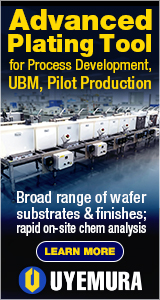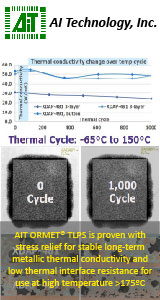|

|
|
| Ask the Experts | |||||||
|
|||||||
|
July 31, 2021 - Updated October 6, 2008 - Originally Posted Oxidation on SMT Pads Causing Solder ProblemsWhat causes oxidation on surface mount pads? We believe oxidation on BGA pads is resulting in poor solder joints. M. M. |
|||||||
| Expert Panel Responses | |||||||
|
In a nutshell, oxidation is the result of prolonged exposure of printed circuit boards to air. However, it is important to first determine whether you are dealing with oxidation as opposed to contamination. Oxidation of pads can be difficult to determine and often requires the process of elimination. Oxidation is a natural process for metallic surfaces when exposed to the environment and cannot be detected visually until it is in an extremely advanced state. Boards finished in gold have a very limited chance of oxidation unless the boards are extremely old or in an environment that is high in humidity. Boards should be received from your board supplier in a vacuum pack, clean and ready to take solder. Once the seal has been broken, the boards become subject to their environment. High humidity will accelerate the process and the longer the exposure, the greater the oxidation potential. Boards should be loaded within a six month (maximum) window. The other possibility is contamination. If your boards are newly out of their safe packaging, are gold or are in a controlled environment, chances are the problem is not oxidation. Most contamination is created at the board manufacturing level and can usually be discovered when the packaging has been opened. Causes at the manufacturing level are a result of faulty conditions such as incorrect ph levels in the rinse bath, improper handling and poorly washed boards with surface film. The safest way to avoid oxidation is the create a dry, clean environment when storing boards not immediately used and to make sure boards are used within a six month window. Contamination of boards is the problem of the board fabricator and should fall within warranty of their product. In some cases where time does not allow for re-fabrication of oxidized or contaminated boards, it is possible to work with your stencil supplier to modify design of your BGA pads to circumvent poor solder joints.
President Integrated Ideas & Technologies, Inc. Mike Ray is founder and president of Integrated Ideas & Technologies, Inc., a manufacturer of SMT stencils. Mike Ray developed the first successful universal frame and holds patents on the AXIS laser system.
Oxidation is the result of oxygen and moisture reacting with the alloys on the pads. In other terms, oxidation is Rust. Just like our cars rust after the protective coatings (paint) have been removed, PCB pads oxidize after sitting unprotected or exposed for too long. Contamination could be an issue as well. If the operators touch the pads with bare fingers it is possible to transfer oils and dirt to the pads. Either way, once the pads are oxidized or contaminated a good cleaning is the best was to start. To avoid the oxidation make sure to handle the boards properly as determined by the type of coating on the pads. Some board finishes are more forgiving that others. For example, ENIG may stand up to longer exposure than either OSP or Silver coated pads. Follow the board manufacturer's recommendations for handling and storage. No matter which board finish you are using, there are a few steps that will help extend the life of the board finish.
Manager of Assembly Technology IPC Kris Roberson has experience as a machine operator, machine and engineering technician and process engineer for companies including Motorola, and US Robotics. Kris is certified as an Master Instructor in IPC-7711 / 7721, IPC A-610 and IPC J-STD 001.
What pad surface finish are you using? Why do you suspect surface oxidation is the reason for BGA failure? Metal surfaces can oxidize when exposed to elevated temperatures and humidity. Most of the surfaces used in electronics are based on noble metals (e.g. ENIG) that don't "oxidize" readily or have some organic component that retards oxidation (e.g. OSP). Take a look at the board handling and storage procedures, keep PCBs stored in a temperature and humidity controlled environment and keep packages sealed as long as possible, minimizing exposure time.
Application Engineering Henkel Electronics Dr. Brian Toleno is the Application Engineering Team leader for Henkel Technologies. He is responsible for the technical service and application engineering for Henkel's electronics assembly materials, including solder paste, underfills, PCB protection materials, and underfills.
Oxidation on the surface mount pads is due to the exposure of the copper to the atmosphere. The degree to which the copper will oxidize depends on the type and quality of the pad surface finish. Some finishes provide greater protection when compared to others. If the surface finish is an Organic Solderability Preservative layer then it is prone to handling damage and results in surface oxidation. Noble finishes (Gold and Silver) tend to last longer and prevent oxidation. If the surface finish is Tin (Sn) then the oxidation potential exists, especially if the finish is uneven and not coated completely.
President inspīre solutions LLC Bjorn Dahle is the President of inspīre solutions LLC. He has 20 years experience in the electronic manufacturing industry with various manufacturing equipment companies covering pick & place, screen printers and thermal process management.
Oxidation on surface mount pads could be caused by poor pcb material manufactured (i.e. there should be a layer of surface protection on the pcb) or due to poor storage environment (humid and maybe over long period of time) of the raw pcb.
Managing Director, Asia Pacific ECD EH Lim has been in the PCB Assy industry since 1985, starting at Thomson/Singapore for 5 years before moving to Electrovert Asia Pacifc. Lim was Sales Director for Vitronics Soltec prior to joining ECD in 2007 as Managing Director for Asia Pacific.
Clean metal surfacesare chemically unstable. They reach a stable statethrough bonding of free oxygen, from the air, to unused bonding locations on the metal atoms. Flux is designed to break the oxygen-metal bond so the solder alloy can form an intermetallic with yourpad. If there is too much oxide, the flux does not have enough capacityto clean the pad. Keeping boards in bags is one way to slow oxidation. The better the bag and the less air entrapped in the bag, the better it will protect the board. Moisture barrier bags and other metalized bags provide the best protection. Vacuum packaging and the use of inert gas to displace air in the bag also reduce oxidation rates.
Application Engineering Supervisor Nordson EFD Mr. Vivari has more than 15 years of electronic engineering design and assembly experience. His expertise in fluid dispensing and solder paste technology assists others in identifying the most cost effective method for assembling products.
Reader Comment
Additionally to all those good advices and comments if possible try to solder with Nitrogen into the oven. A good level would be between 500 and 1000 ppms. Increasing the level of Nitrogen would prevent pads and leads from oxidization.
Domingo Lebron, Magneti Marelli Automotive Lighting
Reader Comment
I agree with Domingo. If your reflow top/bottom and after PTH (wave/selective) each pass through heat increases the oxidation. With no O2 (using N2) the oxidation effect is minimized.
Luiz Felipe Rodrigues, Air Liquide
|
|||||||
| Submit A Comment | |||||||
|
Comments are reviewed prior to posting. You must include your full name to have your comments posted. We will not post your email address. |
|
Free Newsletter Subscription
Circuitnet is built for professionals who bear the responsibility of looking ahead, imagining the future, and preparing for it. Insert Your Email Address |
|

|








